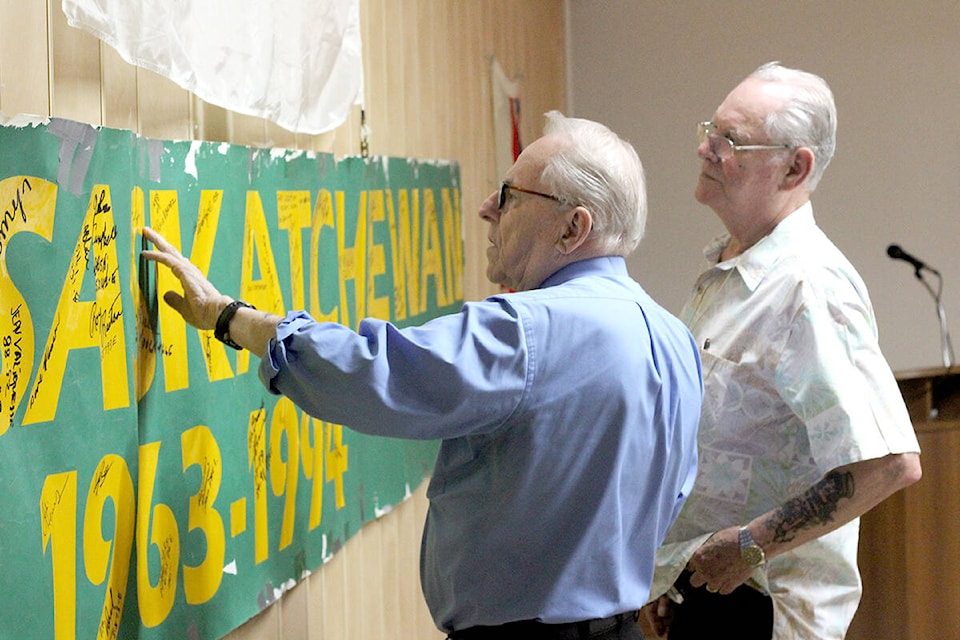The HMCS Saskatchewan rests on the ocean floor, 100 feet down, in the mouth of Nanaimo Harbour. On board the Mackenzie-class destroyer escort vessel are the ashes of seven former shipmen, and that number continues to increase as the men who served on the Saskatchewan decide they want a “happy ship” to be their final resting place.
The HMCS Saskatchewan was commissioned in 1963 and to mark the 60th anniversary, dozens of former crew members gathered for a reunion June 17 at Nanaimo’s Royal Canadian Legion Branch 256.
“We get together, tell lies and laugh,” said Ian Williams, the event organizer and a commissioning crew member. “You go and ask any of them what does the Saskatchewan mean to them and everyone will tell you a different story.”
The HMCS Saskatchewan was a place where they formed bonds as young men.
The commissioning crew of approximately 250 included 63 ordinary seamen who were marching aboard straight from training in CFB Cornwallis, with most of them never having set foot on a naval ship before. Many were teenagers at the start of their service, men of 21 by the end.
“We stayed on board, the majority of us, for 22 months. We got to know each other. We were just kids. We grew up…” Williams said. “Kids nowadays at 21, they’re deciding if they should go to college or not [or] stay in the basement and play video games.”
The commissioning crew of the HMCS Saskatchewan sailed halfway around the world and back. The ship left Esquimalt in mid April of 1963, made it through Panama by month’s end and then anchored off Haiti in case any Canadians needed to be evacuated following a massacre carried out by the dictatorship there. They were in Halifax next, then to Portsmouth, England, back to Halifax, back to Portsmouth, and then up into the north Atlantic where they handled 12-metre waves driven by 110-kilometre gales. On the trip home, they saw bodies pulled out of the sea after a gang war in the Azores, and they arrived in San Diego the day after U.S. President John F. Kennedy was assassinated. By the time they made it back to Esquimalt in late November, the first cruise of the HMCS Saskatchewan had added up to 53,500 kilometres.
It wasn’t all storms and strife. There were good feelings on board, and everybody liked one another, said Don Reid, another member of the commissioning crew who worked the evaporators, making fresh water out of salt water. He “made like a tourist” every chance he got and had great company on his excursions.
“I had a few guys I chummed around with, but always ended up with a couple extra guys from other parts of the ship that joined us,” he said.
The HMCS Saskatchewan, now on Nanaimo’s ocean floor, was once the "best in the west."
— Nanaimo Bulletin (@NanaimoBulletin)
A reunion last month in Nanaimo recognized the 60th anniversary of the Royal Canadian Navy vessel’s commissioning…
(üì∑≥“∞˘±≤µ≥ß≤π∞Ï≤π∞Ïæ±/±∑±∑…≤ıµ˛≥бٱٱ≥Ÿæ±≤‘)
For Williams, one of his trips to shore was life-changing. Within four hours of landing in Portsmouth the first time, he came across a young lady trying to ditch the “bozo” she was with, and so he took her by her free hand. A year and a half later, she emigrated to Canada, and two and a half years after that, the couple were married.
Following the first cruise of the HMCS Saskatchewan, some shipmen finished their naval duties and some moved to other ships, and were replaced by what were called the first crew. That group, and the shipmen who followed, strived to make sure the ship remained “the best in the west.”
Gary Robertson, part of that first crew, worked in engineering and said he remembers an admiral commenting that the ship was so clean he could eat off the floor of the engine room. It was “one hell of a happy ship,” Robertson said. The men had bridge, chess and rowing competitions and they looked out for one another.
“People on the ships are always in pairs. Your winger, your life depends on him, his life depends on you, and when you get that camaraderie, it just spreads out to whatever division you happen to be in,” Robertson said. “And for the Saskatchewan, for some reason or other, it went beyond that.”
The HMCS Saskatchewan never fired a shot in anger, but had a mighty reputation. Robertson remembers his winger, who dead-panned jokes all day every day, convincing American counterparts in Pearl Harbor that Canadian ships were fitted with more missiles than portholes to fire them out of, and that the Saskatchewan’s bow doors opened so that mechanical arms called “shakers” could be extended down into the water to rattle enemy submarines into submission.
In its later years, the Saskatchewan was a training ship, the last of its kind before recruits started training from shore on simulators, said Cdr. Neil Sorsdahl, the ship’s last captain.
“It was always a very happy ship…” he said. “It had a reputation. You go on board and this is the best in the west and you have to maintain that.”
The ship was decommissioned in 1994 and sunk in 1997, but before that, Robertson, decades after his service with the navy ended in 1966, happened upon the HMCS Saskatchewan quite randomly in New Westminster. He saw only the tip of its mast from blocks away, but that was enough, and he followed it to the pier to get another good look at the best in the west and remember the old days.
“The happy times on board her, the type of people that were on board her, I thought I had lost a lot of it,” he said. “Until my wife saw on Facebook and said, ‘what about this reunion?’ So I called Ian up and he said, ‘where the hell have you been?”
READ ALSO:
READ ALSO:
editor@nanaimobulletin.com
Like us on and follow us on



